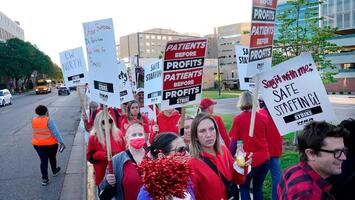
In my thirty years in the labor movement, I’ve never seen a moment quite like this one. We’re living through a pivotal moment for America’s working class and for the future of U.S. labor, but it’s more than that. This is a major shift in the social and economic order.
In order to see the path forward, we have to consider what’s different from the system we’ve operated in for the last 40 years. The last time we saw such a shift began in the 1970s, when markets-are-always-right thinking eclipsed New Deal ideas that prioritized checks and balances on capital.
Now market-centric neoliberal thinking is weakening. The pandemic is key. There’s far more public awareness about how poorly workers have been treated, and this has driven up public support for unionism. A full 71 percent approve of unions, according to recent Gallup polling, which is the highest level since 1965. Gen Z is the most pro-union generation alive, according to a new analysis by the Center for American Progress. Gen Zers are more supportive of unions than were Boomers, GenXers or Millennials at the same age.
Yet the shift we’re living through together actually started before the pandemic with the Great Recession of 2008-09 when new, diverse movements began to challenge the status quo. The Occupy Movement of 2011 united people under the banner of “We are the 99%.” The Black Lives Matter movement in 2013, the #metoo movement in 2017, and the Day Without an Immigrant in 2017 all laid bare the hollow promise of a neoliberal system in which “equity” merely meant equal access to the market, not fundamental reform.
Even before the pandemic, labor activity increased to new levels. There were more people on strike in 2018 and 2019—half a million a year—than in any year in the previous thirty. The #RedforEd strikes brought out teachers in a host of conservative-leaning states, and unlike in the 1970s and 1980s, they enjoyed enormous public support for their walkouts. Fight for $15 effectively raised minimum wages in many cities and states.
People no longer believe the “Washington consensus” that prioritized unfettered corporate access to global markets, no matter the cost to workers and communities. Our lived reality has revealed the false promises of neoliberalism. Wildfires, floods and heat waves all make us see the climate crisis and the need for structural reform. Workers are pushing back against the kinds of bad jobs that have become the norm over the last 40 years.
Yet the erosion of the neoliberal order isn’t a guaranteed win for workers. Rather, the shift has helped spark a global political backlash, including the election of Donald Trump in 2016, the UK’s Brexit, and other right-wing, populist fronts that threaten the advance of democratic ideals. Though Democrats squeaked out the Senate in this most recent election, ultra right-wing voices remained a potent force.
The post-neoliberal world could move in a direction that is neo-authoritarian and that is fundamentally elitist and anti-democratic. Or it could be a turn to a communitarian, multiracial democracy that is based in the common good. In order for labor to help ensure that the second option prevails, we must help forge a new order that lifts all working people.
Read the rest of this piece at Working-Class Perspectives.
Lane Windham, Ph.D., is the Associate Director of the Kalmanovitz Initiative for Labor and the Working Poor at Georgetown University and author of Knocking on Labor’s Door: Union Organizing in the 1970s and the Roots of a New Economic Divide. She is also co-director of WILL Empower.












